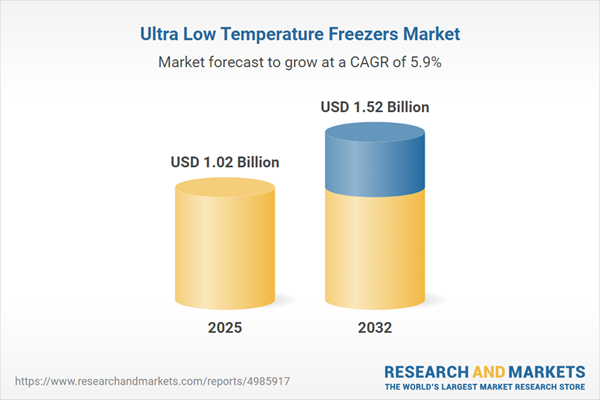Speak directly to the analyst to clarify any post sales queries you may have.
Ultra low temperature freezers are essential infrastructure for scientific research, healthcare, and biomanufacturing, providing secure and compliant storage for sensitive biological and pharmaceutical materials. As laboratory demands intensify and compliance expectations rise, these systems increasingly underpin critical operations in facilities worldwide.
Market Snapshot: Growth and Performance of the Ultra Low Temperature Freezers Market
The Ultra Low Temperature Freezers Market grew from USD 966.95 million in 2024 to USD 1.02 billion in 2025. It is expected to continue growing at a CAGR of 5.89%, reaching USD 1.52 billion by 2032. Advanced cooling technologies, rising precision medicine applications, and higher regulatory standards are the key forces shaping expansion within this segment. The increasing need for reliable cold storage drives investment from both established research hubs and developing healthcare sectors worldwide.
Scope & Segmentation
- Product Types: Chest, underbench, upright (single door, double door)
- Storage Capacities: Less than 500 L, 500 to 1000 L, greater than 1000 L (subdivided into 1000 to 2000 L and greater than 2000 L)
- Temperature Ranges: -86°C to -70°C, above -70°C, below -86°C
- Cooling Technologies: Cascade compression (dual stage and single stage), liquid nitrogen, Stirling, thermoelectric
- Control Systems: Digital, mechanical
- Applications: Biobanking (clinical and research biobanks), cell storage (primary cell, stem cell), sample storage (blood, tissue), vaccine storage
- End Users: Academic & research institutes, biopharma & pharmaceutical, chemicals & petrochemical, food & beverage, medical & healthcare facilities
- Regions: Americas (including North America, Latin America), Europe, Middle East & Africa (covering major countries in each), Asia-Pacific (including China, India, Japan, Australia, and others)
- Key Companies: Thermo Fisher Scientific Inc., Eppendorf AG, Panasonic Healthcare Co., Ltd., Haier Biomedical Co., Ltd., Stirling Ultracold LLC, So-Low Environmental Equipment Company, Versati Corp., Arctiko A/S, B Medical Systems S.á r.l., Ilshin BioBase Co., Ltd.
Key Takeaways for Senior Decision-Makers
- Ongoing innovation in thermal insulation and refrigeration cycles is reducing overall environmental impact while maintaining reliability in sample preservation across diverse scientific and medical contexts.
- The integration of advanced connectivity features, including real-time diagnostics and remote monitoring, is becoming central to asset management and preventive maintenance in modern laboratory infrastructure.
- Regulatory requirements result in greater investment in quality control, with institutions increasingly seeking equipment that provides comprehensive logging, alarms, and compliance features as standard.
- Sustainability objectives are reshaping procurement criteria, favoring energy-efficient, low-emission systems that contribute toward institutional net-zero targets and operational cost optimization.
- Market segmentation by product format, storage size, and application enables end users to tailor freezer investments to workflow requirements, supporting both niche research and large-scale biopharma production needs.
- Leadership positions are being consolidated through partnerships, localized manufacturing, and enhanced user support programs, which shorten delivery times and improve service consistency throughout global regions.
Tariff Impact: Influence on Supply Chains and Domestic Manufacturing
Recent tariff adjustments in the United States have influenced procurement strategies, increasing the focus on domestic sourcing and local assembly partnerships. These shifts have prompted original equipment manufacturers and contract producers to reevaluate their U.S. manufacturing footprints. Effects ripple into longer supply cycles and adaptations in contract terms to ensure continued access to reliable cold storage solutions amidst changing import cost structures.
Methodology & Data Sources
This research leverages confidential interviews with laboratory managers and procurement leaders, supported by structured surveys and rigorous validation. Comprehensive secondary analysis incorporates industry documentation, vendor catalogs, regulatory frameworks, and patent records. Expert panels reviewed all findings to ensure a balanced, actionable narrative for industry stakeholders and policy shapers.
Why This Report Matters
- Executives and technical leaders can benchmark their cold storage investments against global best practices for regulatory compliance and sustainability.
- The evaluation of technology adoption, supplier positioning, and regional trends enables strategic supply chain and procurement planning aligned to emerging operational risks and opportunities.
- Insights into segmentation help target investments in product formats and solutions best suited to evolving research, clinical, and manufacturing demands.
Conclusion
The Ultra Low Temperature Freezers Market continues to evolve through innovation in technology, compliance, and sustainability. Stakeholders benefit from detailed insights that inform capital planning and operational resilience. This analysis provides a robust foundation for confident decision-making in a competitive and changing market landscape.
Additional Product Information:
- Purchase of this report includes 1 year online access with quarterly updates.
- This report can be updated on request. Please contact our Customer Experience team using the Ask a Question widget on our website.
Table of Contents
3. Executive Summary
4. Market Overview
7. Cumulative Impact of Artificial Intelligence 2025
Companies Mentioned
The companies profiled in this Ultra Low Temperature Freezers market report include:- Thermo Fisher Scientific Inc.
- Eppendorf AG
- Panasonic Healthcare Co., Ltd.
- Haier Biomedical Co., Ltd.
- Stirling Ultracold LLC
- So-Low Environmental Equipment Company
- Versati Corp.
- Arctiko A/S
- B Medical Systems S.á r.l.
- Ilshin BioBase Co., Ltd.
Table Information
| Report Attribute | Details |
|---|---|
| No. of Pages | 190 |
| Published | October 2025 |
| Forecast Period | 2025 - 2032 |
| Estimated Market Value ( USD | $ 1.02 Billion |
| Forecasted Market Value ( USD | $ 1.52 Billion |
| Compound Annual Growth Rate | 5.8% |
| Regions Covered | Global |
| No. of Companies Mentioned | 11 |









